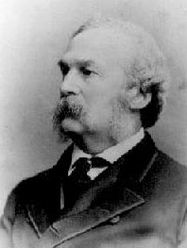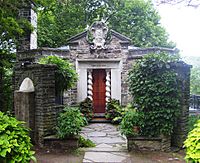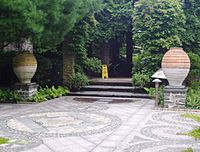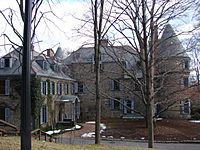Grey Towers National Historic Site facts for kids
|
Gifford Pinchot House
|
|
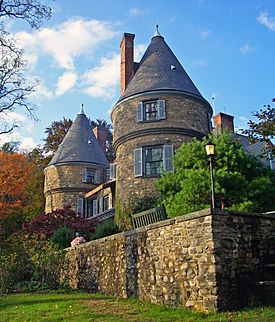
Two of the fieldstone chateau's three conical towers (2007)
|
|
| Location | Milford, Pennsylvania, U.S. |
|---|---|
| Nearest city | Port Jervis, New York, U.S. |
| Area | 102 acres (41 ha) |
| Built | 1886 |
| Architect | Richard Morris Hunt H. Edwards Ficken |
| Architectural style | Neo-Norman |
| Website | Grey Towers National Historic Site |
| NRHP reference No. | 66000694 |
Quick facts for kids Significant dates |
|
| Added to NRHP | October 15, 1966 |
| Designated NHL | May 23, 1963 |
Grey Towers National Historic Site is a special place in Milford, Pennsylvania. It was once the summer home of Gifford Pinchot. He was the very first chief of the United States Forest Service (USFS). He also served two terms as the governor of Pennsylvania.
The house looks like a French château, which is a large country house or castle. This style was chosen to honor the Pinchot family's French background. Famous architects Richard Morris Hunt and H. Edwards Ficken designed it. Grey Towers sits on hills overlooking the beautiful Delaware River.
Gifford Pinchot grew up here and returned every summer. His wife, Cornelia Bryce Pinchot, made many changes to the house and gardens. She worked with different architects to make it perfect for entertaining guests.
In 1963, the Pinchot family gave the house and its 102 acres to the Forest Service. It is the only U.S. National Historic Site managed by this agency. Three years later, it became a National Historic Landmark. Today, you can visit Grey Towers for tours and hiking on its trails. It is also home to the Pinchot Institute, which continues Gifford Pinchot's important work in conservation.
Contents
Exploring Grey Towers: The House and Gardens
The main house is a large, L-shaped building made of fieldstone. It has three towers with pointy, cone-shaped roofs, which give the property its name. When it was first built, it had 43 rooms! The first floor included a big entrance hall, a billiard room, a dining room, a library, and a sitting room. Bedrooms were on the second and third floors, along with playrooms for children.
Unique Outdoor Features
The estate has many interesting smaller buildings and areas. On the original 303 acres, there are 48 different structures. Many of these are important to the site's history.
- The Letter Box and Bait Box: These are small, charming cottages. The Bait Box was a playhouse for the Pinchots' son. The Letter Box was used as an office for Gifford Pinchot's political staff.
- The Finger Bowl: This is a very unique outdoor dining area. It has a raised pool surrounded by a flat ledge. Food was served from bowls floating on the water!
- Forester's Cottage: This cottage was used as a home by the Pinchot family's descendants.
- White Pine Plantation: Gifford Pinchot started this area to plant Eastern White Pine trees. He wanted to help regrow the forests in Pike County.
A Look Back: The History of Grey Towers
The history of Grey Towers can be divided into four main parts. These include its building by James Pinchot, the years with Gifford and Cornelia, its time with the Forest Service, and recent efforts to preserve it.
James Pinchot: The Founder's Vision
In 1875, Gifford's father, James Wallace Pinchot, retired from his successful wallpaper business. He bought 3,000 acres of land overlooking the Delaware River. He especially loved a small waterfall on Sawkill Creek.
James Pinchot spent his time planning Grey Towers and its surroundings. He wanted an "ornamental farm" with beautiful orchards. In 1884, he asked his friend, architect Richard Morris Hunt, to design a French-style chateau. It was inspired by the Marquis de Lafayette's home, reflecting the Pinchot family's French roots.
Construction finished two years later, in 1886. James Pinchot made some small changes to save money. He also had H. Edwards Ficken adjust the design when building on the rocky ground was difficult. Ficken added decorative touches like the front door and wrought iron porches.
Most building materials came from nearby areas. Hemlock wood floated down the Delaware River. Bluestone and windows came from Shohola. Roofing slate came from New Jersey. All the workers were from Milford. The house cost $19,000 to build, and furnishings cost $24,000.
James Pinchot later felt bad about the environmental damage caused by industries like his. He helped start the Yale School of Forestry, the first graduate forestry program in the U.S. From 1901 to 1926, Grey Towers was used for the school's summer fieldwork.
Gifford and Cornelia: Modernizing the Estate

James Pinchot passed away in 1908. Gifford Pinchot and his brother, Amos, divided the estate. Gifford received the main house. He and his wife, Cornelia Bryce Pinchot, began spending their summers there.
Cornelia realized that Gifford's political career meant they needed a home suitable for entertaining important guests. She decided to modernize the house. Many changes were made to the first floor. The dining and breakfast rooms were combined to create a large sitting room. The library was also made bigger by adding the living room to it. Gifford Pinchot said his wife "broke down the partition walls and let in light and air ... of course, it's a vast improvement."
Cornelia was also a passionate gardener. She focused on improving the grounds.
- Swimming Pool: Architect Chester Holmes Aldrich designed a raised swimming pool for the property.
- Bait Box: This was a playhouse for their son, Gifford Bryce Pinchot.
- Letter Box: In the late 1920s, this small cottage was built. It stored Gifford's important papers and served as an office for his political staff.
- Moat: Aldrich and Cornelia Pinchot added a moat around the house. This gave the house the raised look that Hunt had originally wanted.
In the early 1930s, Cornelia hired William Lawrence Bottomley to create the unique Finger Bowl outdoor dining area. Later, Gifford Pinchot started the White Pine Plantation to reforest old farmland. He was very interested in white pines because they were common in Pike County but had been heavily cut down.
Grey Towers with the Forest Service
After his mother passed away in 1960, Gifford Bryce Pinchot gave Grey Towers to the Forest Service. The family had planned this for a long time. The agency wanted to use the house as a conference center. They had to fix some interior walls that were damaged by insects and water. Other rooms were turned into offices or storage. The swimming pool was filled in during 1979 because it became a safety issue. A parking lot was also built.
The Pinchot Institute was officially opened by President John F. Kennedy on September 24, 1963. That same year, Grey Towers became one of the first sites named a National Historic Landmark.
By 1980, the USFS realized that some of its changes had harmed the historic building. They began working to restore the house and estate to how it looked during Gifford Pinchot's time. They worked with experts in landscape and architecture. After closing for renovations, Grey Towers reopened on August 11, 2001, which was Gifford Pinchot's birthday. The state of Pennsylvania also helped with $2 million for renovations to the entrance and parking areas. In 2007, the USFS even restored the swimming pool.
Visiting Grey Towers Today
The grounds of Grey Towers are open every day from 9 a.m. to 4:30 p.m. This is from Memorial Day weekend through October. Guided tours of the home and gardens start every hour from 11 a.m. to 3 p.m. There is a small fee for tours, but sometimes they are free.
You can also explore self-guided trails on the grounds. These trails teach you about the Pinchot family, forestry, and the bluebirds that live in the woods. There is also a gift shop where you can find souvenirs.
The Pinchot Institute also holds conferences about conservation. These events take place in the mansion's upper floors or in the Letter Box cottage.
Gallery


